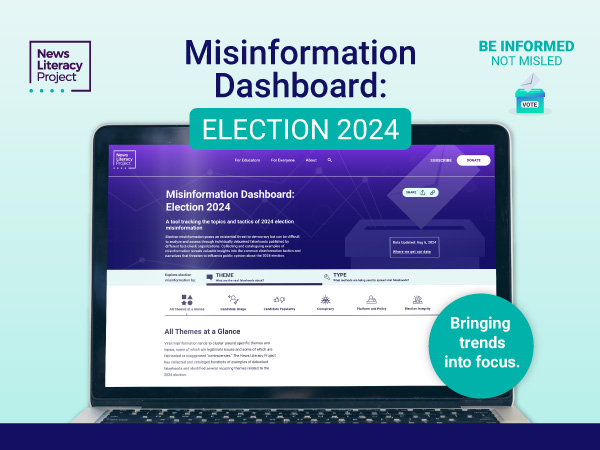
New election misinformation dashboard tracks the trends
Election misinformation has been coming at us at such a furious clip this summer that you would have to be faster than an Olympic sprinter to outpace it. And even if you could, making sense of what you see and hear sometimes feels impossible.
That’s why we have created the Misinformation Dashboard: Election 2024. This free online resource collects examples of viral rumors, doctored images, conspiracy theories and AI-generated fakes. Because election misinformation poses an existential threat to democracy, individual fact-checks are not adequate to counter this danger.
The dashboard goes above and beyond by doing the following:
- Highlighting of-the-moment data.
- Analyzing common trends and topics within a larger context.
- Featuring dynamic visualizations that quickly illuminate information.
- Providing educators with real-time examples for the classroom and enhancing the understanding of journalists and researchers diving into election misinformation.
“Given how quickly falsehoods can congeal into deep-seated beliefs, it’s essential that all Americans learn to recognize viral election misinformation when they see it in their feeds,” said Senior Vice President of Research and Design Peter Adams, who led the development of the dashboard. “Healthy democracies flourish when civic discourse is anchored in accurate, shared understandings of issues and candidates. We hope this dashboard helps people preserve the integrity and power of their civic voices and their votes.”
Everything on the dashboard is interactive. Click on the two options at the top of it to explore election misinformation by theme or type. You’ll find examples of fabricated or manipulated content, false or misleading context and many forms of AI-generated deceptions. And we’re tracking the trends regarding election integrity, party platforms and the candidates themselves.
“Patterns in misinformation come into focus when content is collected in one place. The dashboard empowers people to see trends so they can avoid being swayed by falsehoods when they cast their votes,” said Dan Evon, NLP’s Senior Manager of Education Design, and a member of the team that developed the resource.
